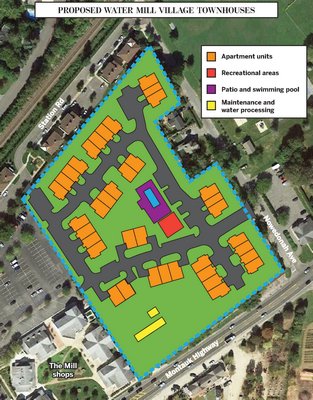
The Southampton Town Planning Board has finished the environmental review process for a 38-unit townhouse complex, clubhouse, swimming pool and sewage treatment plant proposed off Montauk Highway in Water Mill. The next step is for the board to accept, or reject, that plan.
Southampton Town Planner Claire Shea unveiled the 10-page State Environmental Quality Review Act, or SEQRA, documents at a Planning Board work session on August 23. She recommended the board adopt a negative declaration—meaning the board finds there is no substantial evidence that the project may have a significant effect on the environment—for the planned development district, or PDD.
“It’s consistent with the community look and character,” Ms. Shea said.
With consideration of environmental, aesthetic character and transportation impacts of the townhouse project, the need for “traffic calming” measures—like a crosswalk and speed bumps—was the only request of the applicant outlined in the SEQRA documents.
Attorney Mary Jane Asato said her client—the property is owned by Watermill Village Associates II LLC, according to town records—would be amenable.
“A lot of residents were concerned about traffic down that road,” Ms. Asato said. “We have no position on this. If it needs to be done, sure.”
Traffic going in and out of the complex will use Nowedonah Avenue instead of Montauk Highway. The avenue has a traffic light and leads to Station Road.
This is not the first large-scale development project proposed at this location. Board Chairman Dennis Finnerty said in an interview that a shopping center with a mix of retail and residential spaces was once proposed on the three parcels—totaling 6.45 acres—but was met with stiff opposition from area residents.
Since 1986, there were multiple attempts to put a 28,000-square-foot supermarket there, but those efforts all failed—especially after the Water Mill Shoppes were built next door in the 1990s, making the call for more retail in the area fall on deaf ears. Hamlet studies in 2001 and 2004 recommended the property should be used for residential and office space.
As part of the PDD, four of the 38 units will be reserved for affordable housing for low-income residents.